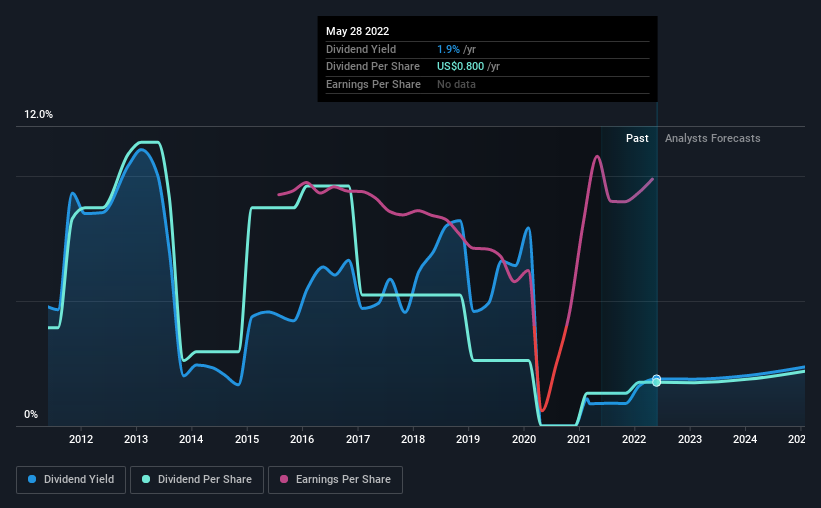Is It Smart To Buy Bath & Body Works, Inc. (NYSE:BBWI) Before It Goes Ex-Dividend?
Bath & Body Works, Inc. (NYSE:BBWI) stock is about to trade ex-dividend in 3 days. The ex-dividend date occurs one day before the record date which is the day on which shareholders need to be on the company's books in order to receive a dividend. The ex-dividend date is important as the process of settlement involves two full business days. So if you miss that date, you would not show up on the company's books on the record date. Therefore, if you purchase Bath & Body Works' shares on or after the 2nd of June, you won't be eligible to receive the dividend, when it is paid on the 17th of June.
The company's next dividend payment will be US$0.20 per share, on the back of last year when the company paid a total of US$0.80 to shareholders. Last year's total dividend payments show that Bath & Body Works has a trailing yield of 1.9% on the current share price of $42.45. Dividends are a major contributor to investment returns for long term holders, but only if the dividend continues to be paid. That's why we should always check whether the dividend payments appear sustainable, and if the company is growing.
View our latest analysis for Bath & Body Works
If a company pays out more in dividends than it earned, then the dividend might become unsustainable - hardly an ideal situation. Bath & Body Works is paying out just 15% of its profit after tax, which is comfortably low and leaves plenty of breathing room in the case of adverse events. Yet cash flow is typically more important than profit for assessing dividend sustainability, so we should always check if the company generated enough cash to afford its dividend. The good news is it paid out just 9.8% of its free cash flow in the last year.
It's encouraging to see that the dividend is covered by both profit and cash flow. This generally suggests the dividend is sustainable, as long as earnings don't drop precipitously.
Click here to see the company's payout ratio, plus analyst estimates of its future dividends.
Have Earnings And Dividends Been Growing?
Companies with consistently growing earnings per share generally make the best dividend stocks, as they usually find it easier to grow dividends per share. If business enters a downturn and the dividend is cut, the company could see its value fall precipitously. This is why it's a relief to see Bath & Body Works earnings per share are up 3.4% per annum over the last five years. Bath & Body Works is retaining more than three-quarters of its earnings and has a history of generating some growth in earnings. We think this is a reasonable combination.
Many investors will assess a company's dividend performance by evaluating how much the dividend payments have changed over time. Bath & Body Works's dividend payments per share have declined at 7.8% per year on average over the past 10 years, which is uninspiring. It's unusual to see earnings per share increasing at the same time as dividends per share have been in decline. We'd hope it's because the company is reinvesting heavily in its business, but it could also suggest business is lumpy.
To Sum It Up
Is Bath & Body Works worth buying for its dividend? Earnings per share growth has been growing somewhat, and Bath & Body Works is paying out less than half its earnings and cash flow as dividends. This is interesting for a few reasons, as it suggests management may be reinvesting heavily in the business, but it also provides room to increase the dividend in time. We would prefer to see earnings growing faster, but the best dividend stocks over the long term typically combine significant earnings per share growth with a low payout ratio, and Bath & Body Works is halfway there. Bath & Body Works looks solid on this analysis overall, and we'd definitely consider investigating it more closely.
While it's tempting to invest in Bath & Body Works for the dividends alone, you should always be mindful of the risks involved. To that end, you should learn about the 4 warning signs we've spotted with Bath & Body Works (including 1 which makes us a bit uncomfortable).
If you're in the market for strong dividend payers, we recommend checking our selection of top dividend stocks.
Have feedback on this article? Concerned about the content? Get in touch with us directly. Alternatively, email editorial-team (at) simplywallst.com.
This article by Simply Wall St is general in nature. We provide commentary based on historical data and analyst forecasts only using an unbiased methodology and our articles are not intended to be financial advice. It does not constitute a recommendation to buy or sell any stock, and does not take account of your objectives, or your financial situation. We aim to bring you long-term focused analysis driven by fundamental data. Note that our analysis may not factor in the latest price-sensitive company announcements or qualitative material. Simply Wall St has no position in any stocks mentioned.

 Yahoo Finance
Yahoo Finance 
